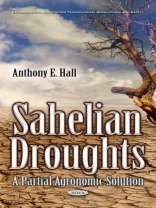Dr. Hall is an Emeritus Professor who retired in 2003. For 32 years he held a joint appointment as a Professor of Plant Physiology at the University of California, Riverside and as a Crop Ecologist in the California Agricultural Experiment Station. He collaborated with African colleagues in education and the development and extension of improved cowpea varieties and management methods, breeding seven cowpea varieties. He received the USDA Secretary’s Honor Award in 2001 and the USAID/BIFAD Chair’s Award for Scientific Excellence in 2000. In 1993 he was elected a Fellow in the Crop Sciences Society of America and the American Society of Agronomy. He wrote "Crop Responses to Environment" in 2001 and was the co-Editor of four scientific books. He was the author or co-Author of 173 scientific journal articles, chapters and reviews. In recent years he has advised agencies of the United Nations and various foundations concerning the types of agricultural research needed to promote rural development in Africa. The Sahelian zone stretches across Africa from Senegal and Mauritania in the west to Sudan in the east, passing through Mali, Burkina Faso, Niger and Chad. The Sahel transition zone is adjacent to the southern boundary of the Sahara Desert, and its agriculture usually is limited by droughts. Since 1970, the droughts have been even more extreme, and major food crops produced little food/forage for livestock for many years. Millions of people living in the Sahel have suffered from famine and hundreds of thousands of people have died. As of 1974, it was estimated that the livestock population had decreased by about 80%. In the early 1970s, while working as an agronomist/ Professor at the University of California in Riverside and conducting collaborative research in Senegal, Dr. Hall designed a partial agronomic solution to these droughts. In implementing this solution, he collaborated with African students and scientists to breed cowpea varieties that could withstand these droughts and provide food for people and livestock alike. Early-flowering cowpea varieties with resistance to drought, various pests and diseases were bred by researchers in California, Senegal, Sudan and Ghana. Cowpea varieties were released in Senegal, Sudan and Ghana that have produced significant amounts of food in years when traditional cowpea varieties and other staple food crops died out. Enhanced cowpea breeding and agronomy programs now are being conducted by African scientists in Senegal, Burkina Faso, Niger, Cameroon, Nigeria, Ghana and Sudan.Target Audience:This book is intended for a wide range of people who are interested in agriculture, agronomy, plant breeding, plant physiology, adaptation to droughts, extension of technologies, rural development in poor countries, Africa and science.
Anthony E Hall
Sahelian Droughts [PDF ebook]
A Partial Agronomic Solution
Sahelian Droughts [PDF ebook]
A Partial Agronomic Solution
Beli ebook ini dan dapatkan 1 lagi PERCUMA!
Format PDF ● Halaman-halaman 228 ● ISBN 9781536104431 ● Penyunting Anthony E Hall ● Penerbit Nova Science Publishers ● Diterbitkan 2017 ● Muat turun 3 kali ● Mata wang EUR ● ID 7216186 ● Salin perlindungan Adobe DRM
Memerlukan pembaca ebook yang mampu DRM












